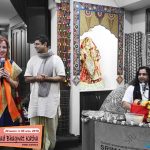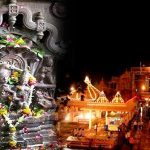The Ramayana is an all-popular epic in South and Southeast Asia. It is the story of King Rama who must save his kidnapped wife, Sita. Along the way, it teaches Hindu life lessons. The Ramayana is told and retold orally, through literature (and comic books!), plays, movies and is reference in many other forms of popular culture today.
Rama and Sita, the ideal couple, Sita captured by the evil King Ravana, Rama Taking the help of Monkey God Hanuman, Killing the Evil and rescuing the Sita, is the classic love story with universal appeal of good versus Evil has influenced the South Eastern Asian countries so much that each country has its own version of the tale.

Recently a 5- day Ramayana festival, starting on January 20, has been organised by the Indian Council for Cultural Relations (ICCR). Cultural groups from the 10 member-countries of the Association of Southeast Asian Nations (ASEAN) will present performances based on the epic at the five-day Ramayana Festival to celebrate the India-ASEAN dialogue platform. The festival will be held in the national Capital and five other cities, including Ayodhya. Some of the performances will be staged in Ahmedabad, Hyderabad, Lucknow and Kolkata.
On the occasion ICCR head Vinay Sahasrabuddhe announced a multi-cultural festival to mark over 25 years of a platform between India and southeast Asia. Speaking on the occasion “Ramayana is a joint heritage of the eastern world in a way. This is the signature epic of this part of the world and its influence is not confined to India boundaries,” ICCR president Sahasrabuddhe.
Emphasising that India had strong civilisational links with all ASEAN countries, he said performances based on the Ramayana would reflect cultural links between the country and the region. The festival seeks to underline the common cultural heritage and India’s friendship with ASEAN nations.

Let us have a look at the influence of Ramayana across the Southeast Asia –
Ramayana’s influence on Southeast Asia
Valmiki’s epic – Ramayana was brought to the region and has influenced Southeast Asia in many ways. This was due in part to the fact that the story’s universal themes appealed to the local people, and was hence adopted by them.
Many national epics of Southeast Asia were derived from the Ramayana. Examples include the Ramakien from Thailand, Phra Lak Phra Lam from Laos, and Reamker from Cambodia. This shows the Ramayana’s strong influence over literature in many large Southeast Asian countries as so many different national epics were based on this one story.

Furthermore, many traditional dances in the region are also based on this Indian epic. For example, the Kecak dance from Bali is about the battle between Rama, helped by Hanuman, and the evil king Ravana. Also, a genre of dance-drama from Thailand called Khon is based on the Ramakien. All this indicates the presence of the Ramayana’s impact on dance in the region.
There are also many sculptures of characters or scenes from the Ramayana present in Southeast Asia today. This is evidenced by the Statue of Hanuman in Bali, and the many bas-relief depictions of the story in Angkor Wat, clearly showing its influence.
In addition, the Ramayana has also played a part in shaping the traditional practices of Southeast Asian societies. For instance, the Balinese celebrate elaborate Hindu festivals, an example of which is Diwali, based on the Ramayana.

Versions of Ramayana across the Southeast Asia
The Ramayana, an ancient Indian mythological tale loved and revered by Hindus. The story is simple, about the good king Ram who fights and is victorious over the evil Ravana; it spreads the message of dharma, karma, loyalty, devotion to parents and duty towards citizens. Originally written in Sanskrit by sage Valmiki, the Ramayana has been interpreted in different ways in these countries. These adaptations take the basic plot of Valmiki’s Ramayana but modify it according to the culture of their own communities. It is then represented in different ways in their literature, dance, theatre and also temple architecture.
With multiple versions in India itself, there are about 300 variants of the Ramayana. Some of the popular ones are to be found in Indonesia, Cambodia, Thailand, and Malaysia, among other countries.

The Buddhist version:
In Dashratha Jataka, the Buddhist version of the Ramayana, Dashratha was the king of Kashi first and then of Ayodhya. But the main point of departure from Valmiki’s version in this Ramayana is that Rama, Sita and Lakshmana were sent to a hermitage in the Himalayas for twelve years by Dashratha in order to protect them from his over ambitious third wife Kalyani, instead of being banished from the kingdom as is popularly believed.
This is one of those rare versions of the tale that has no mention of the abduction of Sita.
The Jain version:
In this version, Rama is a follower of non-violence. So, it is Lakshmana who kills Ravana and both of them go to hell. Rama, in the end, renounces his kingdom and becomes a Jain monk and eventually attains moksha. He also predicts that both Lakshmana and Ravana will be re-born as upright persons and attain salvation.
In Burma
The Burmese version of the Ramayana is known as Yama Zatdaw and is the unofficial national epic of Myanmar. The plot, the features and characteristics of the characters remain the same in this version, the only difference being the names, which are Burmese transliterations of the Sanskrit names.

In Japan
With the spread of Buddhism in Japan it came to be known as Ramaenna or Ramaensho, in which the character of Hanuman was ignored. In one other variant, Suwa engi no koto written in the fourteenth century, the protagonist, Koga Saburo Yorikata, is the youngest son whose exile is caused by his brothers. In another variant called Bontenkoku, Tamawaka (Rama) is a flute player who escapes with his abducted wife Himegini (Sita) while her captor King Baramon (Ravana) is away for hunting. Other Ramayana-derived stories in Japan including Kifune no honji, Onzoshi shimawatari and Bukkigun, have also demonstrated a deep convergence between the characters of Rama and Ravana.
In China
In China, the earliest known telling of Ramayana is found in the Buddhist text, Liudu ji jing. Unlike in Japan, the impact of Ramayana on Chinese society arguably was responsible for the creation of a popular fictional monkey king’s character, Sun Wukong (Hanuman), in a sixteenth century novel Xiyou ji. We also find characters with the names of Dasharatha, Rama and Lakshmana in a fifth century Chinese text, Shishewang yuan. The Dai ethnic group of south-western Yunnan province also knows the story as Lanka Xihe (Ten heads of Lanka). The epic also spread to Tibet and Mongolia through Buddhism, with a notable variant being that it is Bharata, and not Lakshmana, who accompanies Rama in exile.

In Malaysia
The epic finds mention in Malay Peninsula in the form of Hikayat Maharaja Wana and Hikayat Seri Rama, composed in late 16th century. In these, the most interesting variant is the relationship between Maharaja Wana (Ravana) and Siti Dewi (Sita), who are biological father and daughter. Furthermore, Hanuman Kera Putih (Hanuman) is also depicted as the son of Seri Rama (Rama), born to him in his former life as Dewa Berembun (Lord Vishnu). Malays also believe that Hanuman built the causeway to Langkapuri (Lanka) single-handedly and managed to dissuade the fish princess, Puteri Ikan, from destroying it by marrying her. Interestingly, Hanuman’s marriage with the mermaid also finds mention in the Thai and Khmer variants of the epic.
In Thailand
In the Thai’s Ramakein, composed in 1798, Thotsakan’s (Ravana’s) abduction of Nang Sida (Sita) is presented sympathetically as an act of love and his fall is depicted with sadness. Meanwhile, we find the depiction of various episodes of the Cambodian Reamker on the carved reliefs at world-famous temples of Angkor Wat, Banteay Srei and Baphuon, built around the 10th century. In Laos too, the epic is prevalent as Myongsing Ramayana, Phra Lak Phra Lam and Guay Duorahbi. In Myanmar, the two variants, Rama Thagyin and Maha Rama, composed in the 18th and 19th centuries respectively, are very popular. The Filipinos know Ramayana as Maharadia Lawana and Vietnam’s famous dance-drama lakhon bassac depicts their variant of the epic.

In Indonesia
In Indonesia, the epic was written in 10th century as Kakawin Ramayana with its influence also permeating to Wayang Kulit – one of the oldest and most revered forms of shadow puppet theatre in that region. Interestingly, some variants here include the story of Arjuna Pramada, which elaborates the meeting of Krishna and Arjuna, with Rama and Lakshmana. It says that during the construction of Situbanda (causeway) between South India and Sri Lanka, Arjuna, on the request of Rama, fires an arrow towards Alengka (Lanka) creating the bridge instantly.
No other story in the world is enacted or recited every night somewhere… in a glade, at a temple, on the banks of sacred rivers, in palaces, amidst ruins, in village squares and star hotels, from the Arabian Sea to the Pacific Ocean…. from Kerala to the island of Bali in Indonesia. Each country where the epic is popular, adds its own local flavour to a performance. It is not only language, but also the texts which have been localised, with the characters assuming original dimensions un-thought of by sage Valmiki!
=========
Must Read : Medaram Jatara – Kumbh Mela of Telangana
Must Read : Madhva Navami : Sri Madhwacharya Founder and Exponent of Dvaita Philosophy









